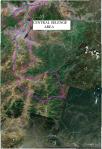Landscape Story
COMDEKS target areas in a geographical mapThe target landscape selected as the focus for COMDEKS projects in Mongolia is the Central Selenge area. Located in the central part of the country, the landscape stretches from southeast towards the north and covers 628,856 ha of mainly forest and mountain ecosystem territories. The distance from Ulaanbaatar, the capital city to the nearest point of the target area is about 135 km by paved road. It is one of the main crop and vegetable growing areas in the country, and is home to a diverse ecosystem of animals and plants. The region is currently at risk due to several factors including green mass and forest depletion, water source depletion, effects of climate change, and environmental pollution.
Biological Impact
The landscape includes two state protected areas, as well as a number of community protected forest areas, and approximately one third of the landscape is covered by forests. Pine and larch trees grow predominantly in the area, which is also rich in wild fruit, berries, pine nuts, and various types of mushrooms. The ecosystem also is home to a range of animals including bears, lynxes, foxes, wolves, moose, and boars, as well as various species of birds and fish. The region is facing growing pressure from human behavior, including timber cutting, livestock grazing, and illegal logging.
Socioeconomic Impact
The Central Selenge target area has a population of about 42,500, originating from the major Mongolian ethnic khalkh group. The primary regional economic activities are crop farming, animal husbandry and mining. Crop land covers 88,437 ha of which 56,625 ha of cereals, 3,483 ha of vegetables, 3,819 ha of fodder crops, 310 ha of fruits and 24,200 ha of lie fallow. The majority of land is state-owned, with the exception of some of the lands in and around settlement areas. In the region, the primary socioeconomic concern is widespread poverty coupled with increasing inequality. Additionally, over the last twenty years, there has been an increase in migration of rural herders towards settled areas as environmental deterioration and increased incidence of natural disaster has increased the costs of relying on agriculture for survival.
Baseline Assessment
The baseline assessment was conducted with the participation of a range of community groups, local stakeholders, and representatives of local governments and civil society organizations in the Central Selenge target area. Several workshops involving 36 participants were held, both with stakeholders and community groups. All 36 participants gave scores to SEPL indicators using the Satoyama Indicator Scorecard.
Landscape Strategy
The overall objective of the Mongolia Landscape Strategy is to demonstrate resilience of the production systems in the target area through the development of sound biodiversity management and sustainable livelihood activities with local communities to maintain, rebuild and revitalize socio-ecological production landscapes. This goal is broken down into the following outcomes:
1) Conservation of biodiversity strengthened and ecosystem services restored and maintained by linking or cohering advanced farming and traditional livelihood practices with protection and conservation measures of community protected areas.
2) Food security in the target landscape enhanced by increasing productivity and sustainability of agro-ecosystems through agro-forestry, watershed restoration, agro-biodiversity management and farming practice diversification.
3) Livelihoods of communities enhanced through diversification of agricultural products, income-generating activities and development of community livelihood enterprises.
4) Institutional governance systems created and/or strengthened through participatory decision making processes and knowledge sharing at the landscape level.
Country Projects
The typology developed through community consultations during the baseline assessment is vital for project proponents to understand the essence of COMDEKS projects and help guide the development of project proposals. Some key areas of focus would be projects that focus on the diversification of agricultural landscapes and agro-forestry systems, as well as forest and ecosystem restoration activities which would enhance landscape resilience and connectivity. Additionally, projects implemented to introduce and promote alternate energy technologies, improve access to credit and market through the development of business plans, and facilitate the construction of community dams and ponds to regulate stream and spring flows would be examples of projects supported through COMDEKS. Finally, other examples of projects encouraged through COMDEKS could focus on community garden development, the promotion of eco and agro tourism, and support of handicraft production.
To learn more, please download the COMDEKS Country Programme Landscape Strategy for Mongolia here.


Project Contact
Mr. Ganbaatar Bandi
National Coordinator
Phone:+ (976-11) 327585-128
Fax:+ (976-11) 326221
Email: ganbaatar.bandi@undp.org
Ms. Narangarav Gankhuyag
Programme Assistant
Phone:+ (976-11) 327585-121
Fax:+ (976-11) 326221
Email: narangarav.gankhuyag@undp.org
Address
UNDP Room 605, UN House – 14201, United Nations Street-14 Sukhbaatar district. , Ulaanbaatar, Mongolia 210646


















